
About UsThe Numismatic Bibliomania Society is a non-profit organization promoting numismatic literature. For more information please see our web site at coinbooks.org SubscriptionsThose wishing to become new E-Sylum subscribers (or wishing to Unsubscribe) can go to the following web page link MembershipThere is a membership application available on the web site Membership Application To join, print the application and return it with your check to the address printed on the application. Membership is only $15 to addresses in the U.S., $20 for First Class mail, and $25 elsewhere. For those without web access, write to: David M. Sundman, Treasurer AsylumFor Asylum mailing address changes and other membership questions, contact David at this email address: dsundman@LittletonCoin.com SubmissionsTo submit items for publication in The E-Sylum, just Reply to this message, or write to the Editor at this address: whomren@gmail.com
BUY THE BOOK BEFORE THE COIN |
- WAYNE'S WORDS: THE E-SYLUM AUGUST 18, 2013
- E-SYLUM WINS 2013 NLG AWARDS
- NEW BOOK: NEW JERSEY STATE COPPERS
- NEW BOOK: FROM CRIME TO PUNISHMENT
- NEW BOOK: AN IRISH ENGINEER
- NEW BOOK: ANCIENT INDIAN COINS
- STACKS-BOWERS TO OFFER HARDBOUND FORD SALES 22-24
- BOOK REVIEW: GOLD COINS OF THE DAHLONEGA MINT, 3RD EDITION
- BOOK REVIEW: HERITAGE'S MICKLEY 1804 DOLLAR CATALOG
- VIGNETTE BOOKS IN THE AUGUST 15, 2013 STACKS BOWERS SALE
- NOTES FROM E-SYLUM READERS: AUGUST 18, 2013
- 1933 DOUBLE EAGLE MOVES UPTOWN TO NEW-YORK HISTORICAL SOCIETY
- QUERY: INPUT FOR 'PRIVATE GOLD COINS' 2ND EDITION SOUGHT
- QUERY: OVERSTRUCK CONFEDERATE HALF RESTRIKE SOUGHT
- QUERY: WHICH COUNTRIES HAVEN'T DEMONETIZED THEIR OLD MONEY?
- QUERY: WERE WALTON'S COINS REALLY SCATTERED ON THE HIGHWAY?
- THE UNSOLVED MYSTERIES OF NUMISGRAPHICS
- L.G. KAUFMAN'S DOLLARS OF THE WORLD EXHIBIT
- INTERVIEW WITH DE LA RUE EXECUTIVE DOUGLAS DENHAM
- FURTHER PRODUCTION PROBLEMS WITH THE NEW $100 BILLS
- COMPANY MAKES A BITCOIN VENDING MACHINE
- WESSEL ISLANDS SEARCH YIELDS SOME CLUES TO COIN ORIGINS
- UNIQUE ANCIENT BRITISH COIN OF AMMINUS FOUND
- COINS LEAD ARCHAEOLOGISTS TO ROMAN FIND
- IRONSIDE’S ‘LOST’ ROYAL ARMS DESIGN STRUCK
- DINER OFFERS 1964 PRICES (WHEN PAID IN SILVER COINS)
- CROW TRIBE PLANS TO ISSUE ITS OWN CURRENCY
- INDIA'S CLEAN BANKNOTE POLICY
- GRAPHIC DESIGNER CRITIQUES THE JANE AUSTEN BANKNOTE
- THE E-SYLUM ROYAL SEX CHANGE POETRY CORNER
- REAL BOOKS PRICED LOWER THAN E-BOOKS
- FEATURED WEB PAGE: CAMP MONEY
Click here to access the complete archive
To comment or submit articles, reply to whomren@gmail.com
WAYNE'S WORDS: THE E-SYLUM AUGUST 18, 2013

We have no new subscribers this week. We have 1,666 email subscribers, plus 241 followers on Facebook.
This week we open with news from the ANA convention that The E-Sylum has won three 2013 awards from the Numismatic Literary Guild. Next up is word of four new numismatic books, ordering information for the new hardbound Ford catalogs, and two book reviews.
Other topics include BEP vignette books, the new New-York home of the only legal 1933 Double Eagle, L.G. Kaufman's Dollars of the World exhibit, camp money, and unsolved mysteries of Numisgraphics and George Walton's "scattered" coins.
To learn more about Joseph J. Mickley, Thomas Goasby, Albion Cox, Walter Mould, and Matthias Ogden, the "weed of crime", the Crow currency, handling gold dust at Fairbanks, Alaska, Christopher Ironside’s ‘lost’ Royal Arms design, Douglas Denham's corkscrew landing, and deep-fried cheese curds, read on. Have a great week, everyone!
Wayne Homren
Editor, The E-Sylum
E-SYLUM WINS 2013 NLG AWARDS
BEST NON-TRADE PRESS WEB SITE: The E-Sylum, The Numismatic Bibliomania Society, Wayne Homren, Editor
BEST WEB SITE TOKEN AND MEDAL ARTICLE: “Heidi Wastweet’s Freedom Girl,” Wayne Homren, The E-Sylum
BEST WEB SITE COLUMN: “Coin Rarities & Related Topics,” Greg Reynolds, CoinWeek.com
Extraordinary Merit: “Numismatic Diary,” Wayne Homren, The E-Sylum
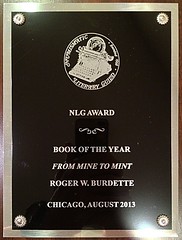
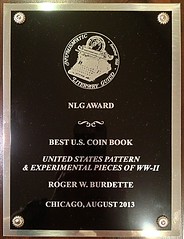
BOOK OF THE YEAR – The work having the greatest potential impact on numismatics: (Tie) The Encyclopedia of United States Silver Dollars 1794-1804, by Q. David Bowers, and From Mine to Mint, by Roger W. Burdette
BEST SPECIALIZED BOOK United States Coins: United States Pattern & Experimental Pieces of WW-II, by Roger W. Burdette
World Coins: South Asian Coins and Paper Money, Indian Edition, George S. Cuhaj, Editor; Rajender Maru, Consulting Editor; Thomas Michael, Market Analyst
U.S. Paper Money: Hilton’s Collecting Confederate Currency, Volume One, by J. Wayne Hilton
World Paper Money: Standard Catalog of World Paper Money, Modern Issues, 19th Edition. George S. Cuhaj, Editor.
Tokens and Medals: Abraham Lincoln, Beyond the American Icon, by Fred Reed
Numismatic Investments: The Insider’s Guide to U.S. Coin Values, 20th Edition, by Scott A. Travers
For more information, visit the NLG web site: www.nlgonline.org
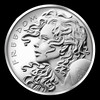 To read the award-winning article, see:
To read the award-winning article, see:
HEIDI WASTWEET'S FREEDOM GIRL
(www.coinbooks.org/esylum_v16n12a22.html)
MORE ON HEIDI WASTWEET'S FREEDOM GIRL
(www.coinbooks.org/esylum_v16n13a15.html)
NEW BOOK: NEW JERSEY STATE COPPERS
 New Jersey State Coppers
New Jersey State Coppers
by Roger S. Siboni, John L. Howes, and A. Buell Ish
Hardcover: 492 pages
ISBN-13: 978-0-89722-323-7
List price: $235 (plus S&H)
Member price: $165 (plus S&H)
As William Sheldon eloquently put it in Penny Whimsy,
Old copper, like beauty, appears to possess a certain intrinsic quality or charm... [with] an almost living warmth and personality not encountered in any other metal.... You see rich shades of green, red, brown, yellow, and even deep ebony: together not elsewhere matched in nature save perhaps in autumn leaves....
Early coppers are rich in die varieties, cracked dies, imperfect and unusual planchets, misstruck coins and other minor variations. ...It is therefore not surprising that to some extent the different die varieties are recognizable by characteristic color and surface texture, as well as by die breaks, peculiarities of the planchet and so on.
New Jersey State Coppers shows that never were these words more true than in the case of the coins struck for New Jersey by Thomas Goasby, Albion Cox, Walter Mould, and Matthias Ogden from 1786 until as late as 1790. By way of introduction, the authors fully discuss the often tumultuous history of the New Jersey copper coinage and its creators alongside the equally compelling story of the men, like Dr. Edward Maris, who first appreciated the “living warmth and personality” of the coins and formed the great collections of the nineteenth and twentieth centuries. Every known New Jersey die variety is presented in minute detail with lavish enlarged full-color illustrations, condition censuses, as well as commentary on die states and other notable features.
The authors also include such supplementary material as the original documents related to the eighteenth- century coining venture, imitations created for the collector market in the nineteenth century, as well as suggestions for developing a personal collection. New Jersey State Coppers will surely become the primary tool for the study of this coinage and the basis for deepening the understanding and appreciation of its charm as old copper.
To pre-order, see: http://numismatics.org/Store/NewJersey
NEW BOOK: FROM CRIME TO PUNISHMENT
 From Crime to Punishment: Counterfeit and Debased Currencies in Colonial and Pre-Federal America (ANS Numismatic Studies 27) by Philip L. Mossman.
From Crime to Punishment: Counterfeit and Debased Currencies in Colonial and Pre-Federal America (ANS Numismatic Studies 27) by Philip L. Mossman.
Hardcover: 304 pages
ISBN-13: 978-0-89722-327-0
List price: $145 (plus S&H)
Member price: $99 (plus S&H)
Ever since coinage was developed in ancient Lydia, an element of society has sought to debase the coin of the realm for personal gain not only by counterfeiting, but also by shaving away precious metal. Currency debasement was not confined to the proletariat since throughout history various monarchs increased their royal revenues, or seigniorage, by reducing the quality of the coins’ specie content or its weight standard. The current text follows closely the course of royal English copper coinages whose high potential profit made them an ideal prey for counterfeiters. These forgeries flowed freely into the colonies where they overwhelmed, and eventually collapsed, the small change medium but not before various states sought to correct the evil of this imported copper trash.
Great attention is paid to Great Britain’s mercantilistic policies which shaped the character of the currency in the North American colonies where chronic hard money shortages encouraged counterfeit coinages of all stripes whose actual manufacture and circulation is examined in great detail. Colonists further sought to expand their monetary pool by printing bills of credit to meet the exigencies of the French and Indian Wars. This new paper currency likewise became the target for forgery and a battle royal ensued between the colonial treasurers and bands of counterfeiters as they competed to outsmart each other. But as “the weed of crime bears bitter fruit,” many counterfeiters were apprehended and punished for their evil deeds.
To pre-order, see: http://numismatics.org/Store/NS27
NEW BOOK: AN IRISH ENGINEER
Meg Vivers of Australia writes:
I have now received some advance copies of my book An Irish Engineer, which is about Tom Waters who designed the Osaka Mint in c. 1869.
in Early Meiji Japan and Beyond
Meg Vivers
Hardcover, RRP in Australia $36.50, ISBN 978-1921452048, CopyRight Publishing, Brisbane, Australia (Softcover version also available.)
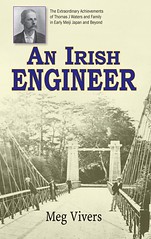 When a young Irish engineer set out from England in 1864 to convert the
world to his evangelical way of thinking, he found himself instead at the
forefront of a remarkable revolution. At a time when industry and transport
driven by steam power had already transformed the Western world, and
engineers were looking elsewhere for employment, Thomas James Waters was
to make a name for himself in what was then known as the Far East, in a
country which had been, until the 1850s, essentially closed to the Western
world and Western progress. That country was Japan, and the revolution was
the Meiji Restoration. Tom Waters was joined in Japan by his brothers, Ernest
and Bertie, and they participated in some of the most important projects in the
early Westernisation of the country. But that was not the end of the story. The
brothers moved on to other parts of the world, including New Zealand and
Colorado, USA, where they became successful mining engineers.
When a young Irish engineer set out from England in 1864 to convert the
world to his evangelical way of thinking, he found himself instead at the
forefront of a remarkable revolution. At a time when industry and transport
driven by steam power had already transformed the Western world, and
engineers were looking elsewhere for employment, Thomas James Waters was
to make a name for himself in what was then known as the Far East, in a
country which had been, until the 1850s, essentially closed to the Western
world and Western progress. That country was Japan, and the revolution was
the Meiji Restoration. Tom Waters was joined in Japan by his brothers, Ernest
and Bertie, and they participated in some of the most important projects in the
early Westernisation of the country. But that was not the end of the story. The
brothers moved on to other parts of the world, including New Zealand and
Colorado, USA, where they became successful mining engineers.
An Irish Engineer takes the form of a biography, with voices from the past adding a sense of place, immediacy and authenticity to the information taken from more public (and sometimes less reliable) documents, such as newspapers and government records. Through the fortunate discovery of a large collection of Waters family letters, diaries and journals the author has, in many cases, been able to trace the movements of Tom Waters and his family from a personal perspective exploring, in-depth, their lives, their achievements, and the choices that they made, in a world on the cusp of extraordinary change.
Within this biographical framework, some of the buildings and other structures created by Tom Waters are described in detail – the most important of these being the Mint at Osaka and Western-style buildings for the Ginza region in Tokyo. There is discussion, too, on the engineering and entrepreneurial activities of the Waters brothers and their relatives elsewhere in the world.
This fascinating narrative crosses international boundaries and engages with generations of men. It is a story of enterprise and opportunism, of networks and family connections. But, most of all, it is a story of beginnings. Because, for such men, being first was the secret to their success. Thomas Waters’ story is intimately involved with the beginning of the Westernised East. As such, it would be of interest to many historians, especially those concerned with the effect of the industrial revolution in Great Britain and the influence of the West on Japan during the early years of Meiji. Furthermore, because the book has a biographical format, and contains extracts from letters and journals, it should appeal to a wider readership.
This is the second book by Meg Vivers on the subject of the Waters family. The first, Castle to Colony: the Remarkable Life and Times of Lucy Sarah Gray (1840–1879), also published by CopyRight, traces the life of Lucy Gray (née Waters), a sister of Thomas, Ernest and Bertie Waters. During her short adult life Lucy lived in some of the most remote parts of colonial New Zealand and Australia, and left behind descriptive journals and correspondence, supported by sophisticated drawings and paintings. In the words of eminent colonial historian, Professor Alan Atkinson: ‘Of all the depictions of colonial Australia which survive from a woman’s point of view, Lucy Gray’s is among the richest and best’.
Comprehensive research into this remarkable family, and the contribution they made to Britain’s influence throughout the world, has long been overdue. Both books provide a better understanding of a period of great economic, industrial, religious and cultural upheaval, as complex liaisons evolved, not only between East and West, but also between Great Britain and its colonies. In his review of An Irish Engineer, Professor David Kent of the University of New England, Armidale wrote:
The grandest and most sweeping histories are distilled from the collected experience of individuals… This well written, impressively researched and fascinating book adds to our understanding of the way the engineering profession evolved in mid-Victorian Britain, of how family networks and connections often provided the platform on which careers might be built …
Copies of An Irish Engineer can be purchased by contacting Meg Vivers in Australia at mvivers@une.edu.au, or through the Telluride Museum in Colorado USA at http://www.telluridemuseum.org/shop/. If posted from Australia, packaging and postage costs would be added to a discount price.
Meg adds:
If any of your members are interested in purchasing a copy they could do so in one of the following ways:
1. For those in Canada or USA it might be convenient to order through the Museum at Telluride, Colorado, at www.telluridemuseum.org/shop/
2. For those living elsewhere it would perhaps be best to order from me direct at mvivers@une.edu.au.
I can provide the book at a discount, but the total charge would depend upon the postage. I use Pay Pal, which seems to be the easiest method for international transactions. I do not know how much the Museum will charge.
I will have both hard cover and soft cover (paper back) versions of the book for sale. However, the soft cover version would seem to be more suitable for posting long distance, at least when multiple copies are involved.
The Telluride Museum will only have the paperback version.
NEW BOOK: ANCIENT INDIAN COINS
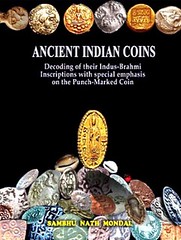 Ancient Indian Coins: Decoding of their Indus-Brahmi Inscriptions with Special Emphasis on the Punch-Marked Coins
Ancient Indian Coins: Decoding of their Indus-Brahmi Inscriptions with Special Emphasis on the Punch-Marked Coins
Authors (s): Sambhu Nath Mondal (Author)
Format: Hardcover
ISBN-13: 9789381209165
Pages: 400p., 19 Colour Plates; Bibliography; Index; 29cm.
Pub. date: 17.08.2013, 1st.ed.
Publisher: Punthi Pustak
Language (s): English
Bagchee ID: BB80327
List price: US $ 247,00
Bagchee price: US $ 222,30
The importance of the study of coins for the reconstruction of the lost history of ancient India is well known to the Indologists and Numismatists. A large number of kings along with the names of their capitals , dynasties and royal epithets are identified only from their coins who may or may not be mentioned in any Sanskrit or Pali or Prakrit text or in any Epigraphic inscriptions.
A Coin , being a metal , survives for one or two millennia with distinct legible symbols punched on it and serves as a still photography of the contemporary periods and is the most dependable of all elements of History. But India's Historiography is incomplete without the proper decoding of the Indus script and the punch-marked coins of the historic period inscribed with Indus-Brahmi legends, instead of haphazardly inscribed and oriented at random.
From the author's exact decoding it reveals that an archaic form of Brahmanism with Paisachi Prakrit-dominated proto-sanskrit, the mother of the Indo-European languages, prevailed from the Oxus valley in the north to the Kaveri valley in the south, the epicentre of which was Ganga-saraswati Basin. From the decodings of the punch-marked coins , the true identities of the Monarchs like Prasenjit of Sravasti and Udaybhadra, Sisunaga , Mahapadma Nanda , Chandragupta Maurya of Magadha as well as Pandukabhaya and Mutasiva of Sri Lanka etc, should be re-written .
The famous three-queen punch-marked silver coin of Maurya emperor, ashoka bearing their names have been unearthed from Mir Zaka of Afghanistan and those unearthed from Kerala and Ruhuna of South eastern sri Lanka reveal that both " Keralaputa and Tambapanni(Sri Lanka) ' were his conquered provinces and those found from Wari Bateshwar of Bangladesh mention that he was the overlord of Pundra country.
For more information, or to order, see: Ancient Indian Coins: Decoding of their Indus-Brahmi Inscriptions with Special Emphasis on the Punch-Marked Coins (www.bagchee.com/books/BB80327/ancient-indian-coins-decoding-of-their-indus-brahmi-inscriptions-with-special-emphasis-on-the-punch-marked-coins)

STACKS-BOWERS TO OFFER HARDBOUND FORD SALES 22-24
From 2003 to 2007 the Stack's firm held twenty-one sales of Ford material, realizing some $60 million if memory serves. This year the Stack's Bowers Galleries firm resumed the series with three more sales, two of which were held at this week's American Numismatic Association convention in Chicago and are available online. -Editor
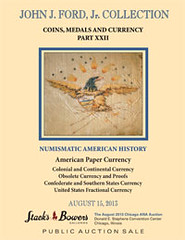
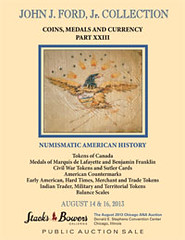
Softbound Ford sales 22 and 23
Brian Kendrella writes:
We will be offering a limited number of the three catalog set (volumes XXII and XXIII from the ANA and volume XXIV from the upcoming Philadelphia Sale) for $150 including shipping. We will take orders but the three catalog set probably won't mail until November. To order your set, please email info@stacksbowers.com or call 800-458-4646.
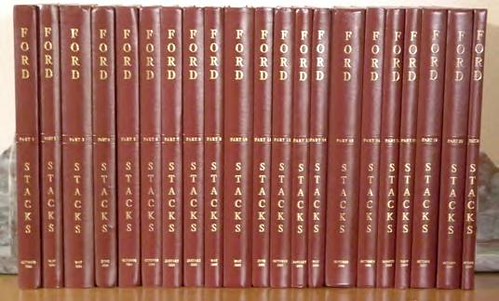
A set of Ford Hardbound Sales 1-21
To read the earlier E-Sylum article, see: MORE JOHN J. FORD TOKENS AND MEDALS COMING TO AUCTION (www.coinbooks.org/esylum_v16n29a18.html)
BOOK REVIEW: GOLD COINS OF THE DAHLONEGA MINT, 3RD EDITION
 I’m delighted to be able to say that I’ve just received my copy of the brand-new third edition of Gold Coins of the Dahlonega Mint: 1838-1861 by Doug Winter!
I’m delighted to be able to say that I’ve just received my copy of the brand-new third edition of Gold Coins of the Dahlonega Mint: 1838-1861 by Doug Winter!
This, the third updated volume of Doug’s series of books on branch mint gold coins (following 2006’s Gold Coins of the New Orleans Mint: 1839-1909 and 2008’s Gold Coins of the Charlotte Mint: 1838-1861) is also published by Zyrus Press (www.zyruspress.com) and has been produced to the same high standards as the preceding books. Although it appears to be only available in softbound form, it is printed on heavy glossy paper and is chock-full of large high-quality color images, with many close-ups of mint varieties. The color images alone make it a worthy successor to the second edition!
The book is laid out in the same format as the New Orleans and Charlotte books, with each coin illustrated in color, a listing of its rarity ranking (both overall and in high grade) and sections discussing Strike, Surfaces, Luster, Coloration, Eye Appeal, Die Varieties, Significant Pieces Known, Auction Record and a breakdown of estimated survivors by Very Fine, Extremely Fine, About Uncirculated and Uncirculated grades.
At 280 pages, the third edition is about 40 pages longer than the second edition that was published in 2003. The book begins with a history of the Dahlonega Mint , a discussion of how to collect Dahlonega Mint coins, a completely revised chapter on die varieties (a “significant improvement” for which Doug credits the assistance of Brian Koller of Heritage Numismatic Auctions and Carl Lester of Gold Rush Gallery), my own two (modest) chapters on gold deposits at, and the officers of, the Dahlonega Mint, an overview of the Dahlonega Mint’s coins and, the real meat of the book, a chapter on each of the four denominations the Dahlonega Mint produced. In a feature that is new to the series, each denomination chapter is preceded by an Overall and Comparative Rarity Analysis which includes Doug’s latest comments on that denomination.
In a very nice touch, the book includes, on page 7, what I believe is still the only known photograph of the Dahlonega Mint, from 1877 when the building was the principal building of the North Georgia College. I still remember the thrill I felt in 1992 when I read Carl Lester’s description, in Bowers and Merena’s Rare Coin Review #89, of the re-discovery of the photograph!
This is the only place I've seen a copy of the book for sale so far: www.translinesupply.com/store/p/5268-Gold-Coins-of-the-Dahlonega-Mint-3rd-Edition.aspx
BOOK REVIEW: HERITAGE'S MICKLEY 1804 DOLLAR CATALOG
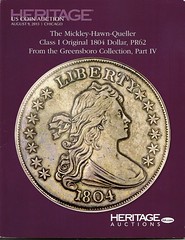 David Stone of Heritage Auctions kindly sent me a review copy of the dedicated catalog for the Mickley-Hawn-Queller Class I 1804 Dollar, which the firm sold on August 8, 2013 for $3,877,500 (including buyer's premium).
David Stone of Heritage Auctions kindly sent me a review copy of the dedicated catalog for the Mickley-Hawn-Queller Class I 1804 Dollar, which the firm sold on August 8, 2013 for $3,877,500 (including buyer's premium).
The 67+ page softcover catalog is a book in itself, "a special expanded version of the lot description... It contains more than two dozen pages of new material, much of it focusing on namesake owner Joseph J. Mickley, including his family, acquaintances, work, and travels. These details, never before gathered in one place, create the fullest portrait yet of one of the most famous U.S. coin collectors of the 19th century."
Consisting of several short chapters contributed by several authors, there is some repetition of a few key facts, but the compendium is quite interesting and useful. I learned several new things about Mickley and the early literature relating to the 1804 dollars. Bibliophiles will enjoy Jon Amato's segment on "American Numismatics in the 1860s and the 1804 dollar" and David Stone's section on "The 1804 Dollar Abroad".
I found George Huber's section on "19th Century Perceptions and Misperceptions About the 1804 Dollar" entertaining. Numismatic research and knowledge about these coins and their collectors has come a long way since the groundbreaking work of Eric Newman, Ken Bressett and others in The Fantastic 1804 Dollar, published in 1962 (not to mention the lengthy treatment by Dave Bowers in The Rare Silver Dollars Dated 1804", published in 1999).
While the authors acknowledge and reference many of their sources within their text, the book lacks the footnotes, endnotes and bibliography I generally look for in any numismatic publication. But I'm very glad to add this to my library, where it will find a home in a growing section of books and monographs concerning this landmark coin and its owners.
A chapter by George Huber titled "Some Views of Joseph Jacob Mickley" covers many aspects of this 19th Century Renaissance Man:
- Joseph J. Mickley the Historian
- Mickley the Tradesman
- Mickley the Philographer (collector of autographs)
- Mickley the Musician
- Mickley the Numismatist
- Mickley the Bibliophile
- Mickley's Later Years
I've selected a couple excerpts for E-Sylum readers.
Jacob Eckfeldt and William E. DuBois revealed the existence of the Class I or "Original" 1804 dollars to the then-small coin collecting community of the United States by including a picture of one in their 1842 reference, the Manual of Coins of All Nations. Matthew Stickney became the first confirmed non-royal, non-government-employee owner of an 1804 dollar in 1843, when he traded a gold Immune Columbia piece - a remarkable numismatic delicacy - as well as other coins to the Mint Cabinet to get his example. The second confirmed piece to come into a collector's hands was this very coin, which had come into the possession of bank teller Henry C. Young in 1850 and was sold to now-legendary numismatist Joseph J. Mickley around 1858. (p8)
Mickley's house on Market Street between Ninth and 10th was literally blocks away from both the first U.S. Mint building and the second Philadelphia Mint building. Mickley and his older brother Jacob did sign the Mint visitors register in 1841, the first documented visit of Mickley to the Mint. There seems little doubt that Mickley would have seen the Mint Cabinet then; it was formed in 1838. The only question is whether 1804 silver dollars were on display during his 1841 visit. It is possible that Mickley became aware of their existence in 1841, before Massachusetts collector Matthew Stickney learned of them via the Eckfeldt-Dubois "Mint Manual," published in 1842. The "Mint Manual" was the first publication that alerted many American collectors to the existence of genuine American silver dollars dated 1804.
Mickley obtained his copy of the "Mint Manual" in 1845, as recorded in his daily business journal, so he certainly became aware of the 1804 silver dollar sometime in the period between 1841 and 1845. One can only imagine how Mickley must have felt during the many years between learning of the existence of the 1804 silver dollars, and the crowning moment when he finally obtained one. The example came from an improbable source: Bank of Pennsylvania teller Henry C. Young, who reportedly fished Mickley's future prize out of his cash drawer for face value. Mickley acquired the coin sometime before 1859, making the window between when he learned of the 1804 dollar and the time he acquired one somewhere from five to more than 15 years. Mickley, even at such an early date, surely recognized his new 1804 silver dollar to be the capstone of his collection -- just as it will be for its next owner.
In all, Mickley is recorded as making 11 visits to the Philadelphia Mint from 1841 to 1848. He likely made many more visits during the next 20 years. With his ingratiating personality, winning ways, and vast local network of personal and business connections, it seems certain that after some of those visits, he walked home with a few more baubles and a bit less cash in his pockets. (p18-19)
To read the basic lot description, see: Lot 5699: The Mickley-Hawn-Queller Class I Original 1804 Dollar, PR62 PCGS From the Greensboro Collection, Part IV (coins.ha.com/c/item.zx?saleNo=1188&lotNo=5699&ic=ih-pr-1804dollar-080913)
To read the complete catalog of the 1804 dollar, see: www.heritagestatic.com/c/i/articles/201308/1804-dollar-description.pdf
THE BOOK BAZARRE
VIGNETTE BOOKS IN THE AUGUST 15, 2013 STACKS BOWERS SALE
Lot 3110: Bound Scrapbook Compilation Of Portrait Die Proof Vignettes
 Fascinating and uniquely style scrapbook with 127 die proof vignettes on card (approximately) affixed as paste-downs upon 34 pages of a scrapbook. Tall vertical oblong, light brown polished leather. 31.0cm by 14.0cm by 4cm thick. Five compartments, four raised bands. Gilt PORTRAITS and named A. L. SCHOMP. A great archive and resource with much diversity.
Fascinating and uniquely style scrapbook with 127 die proof vignettes on card (approximately) affixed as paste-downs upon 34 pages of a scrapbook. Tall vertical oblong, light brown polished leather. 31.0cm by 14.0cm by 4cm thick. Five compartments, four raised bands. Gilt PORTRAITS and named A. L. SCHOMP. A great archive and resource with much diversity.
Notable contents include two pages of Chinese portrait vignettes, most used on notes and many classic portrait styles used in the BEP presentation books. Internal and external condition superior quality. The binding, shape and contents are unusual. Should be seen and a very desirable vignette book. First time we have seen a book of this style and composition in over twenty years of research and cataloguing.
To read the complete lot description, see: Lot #3110. Obsolete Notes. Security Engraving History. Bound Scrapbook Compilation Of Portrait Die Proof Vignettes. (stacksbowers.com/Auctions/AuctionLot.aspx?LotID=530831)
Lot 3111: BEP Presentation Book. Vignettes And Portraits. Ca. 1876
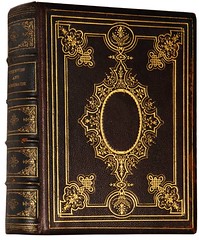 Large vertical octavo, near quarto, 24.0cm by 21.0cm by 6.5cm. Full black morocco with polished surfaces. Intricate gilt embossed panel bordering on both sides featuring interior gilt vine details with central oval; unnamed. Four gilt raised bands forming five compartments with floral emblems and pattern borders. Spine titled: VIGNETTES/ AND/ PORTRAITS second from the top. Dark brown paper interior covers with gilt pattern turned in pattern edging.
Large vertical octavo, near quarto, 24.0cm by 21.0cm by 6.5cm. Full black morocco with polished surfaces. Intricate gilt embossed panel bordering on both sides featuring interior gilt vine details with central oval; unnamed. Four gilt raised bands forming five compartments with floral emblems and pattern borders. Spine titled: VIGNETTES/ AND/ PORTRAITS second from the top. Dark brown paper interior covers with gilt pattern turned in pattern edging.
This is the more frequently seen vertical format vignette book. Includes 139 intaglio die proof vignettes, with interleaved tissue guards, on thick gilt edged cards. An interesting composition. Frontis portrait of Indian and windmill (used on 1876 Centennial certificates) with Treasury title page paste-down with red seal. Long section of 72 portrait vignettes in random order with relatively few presidents and some rarely seen vignettes in these books. Wide selection of 66 other vignettes from various genres. General vignette contents are similar to many used in the books with historical scenes used on National Banknotes, Federal type notes and bonds, large Declaration of Independence and 1876 Centennial Certificate vignette
To read the complete lot description, see: Lot #3111. Obsolete Notes. BEP Presentation Book. Vignettes And Portraits. Ca. 1876. Vertical Format. (stacksbowers.com/Auctions/AuctionLot.aspx?LotID=530831)
Lot 3115: Fractional Currency Presentation Book
Compact, oblong octavo. 16.0 cm by 11.5 cm, 1.0 cm thick. Full red Morocco. Embossed gilt pattern front and back cover frames, turned in gilt to insides covers. Presentation text on front: Italic, ‘’Hon James Harlan’’/ SECRETARY OF THE INTERIOR’’. Ornate embossed gilt pattern spine without compartments, gilt lettered ‘’SPECIMENS/ OF/ UNITED STATES/ FRACTIONAL/ CURRENCY’’ using three fonts. Thirty-one interleaved gilt tipped plates with paste-down uniface Specimen or India paper proof impressions of United States Fractional Currency from the First, Second and Third Issues.
Gengerke Presentation Book #8 (ANA Anthology, 1991). Complete set of 31 impressions as listed in the Gengerke article including variants not known outside the presentation books. The majority are India paper die proofs, some full wide impressions die sunk into the card pages themselves, in their issue colors, but without surcharges or overprints as used on issued notes. Internally, the impressions are nearly all superb, bright and fresh. There is limited foxing on any interleaves or upon the pages. The color backs are especially vibrant in this book. The book itself is bound strongly, just a trifle loose between the satin face page and the First Issue 5 Cents Face Specimen. The front cover is rather worn with central scuffing and red leather flaking at the right. The spine is worn, but the gilt is virtually complete; the titles clear. The back cover is remarkably still bright with only some scattered marks.
A discovery book. Until now known only from the original Spencer Clark presentation list of 13 books and offered to the collecting community for the first time.
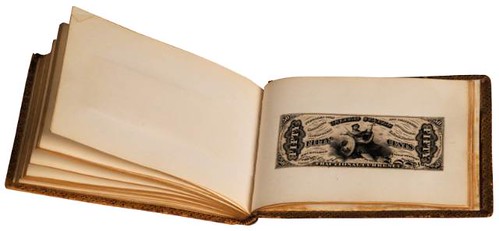
To read the complete lot description, see: Lot #3115. Fractional Currency. Fractional Currency Presentation Book. Named To Hon James Harlan Secretary Of The Interior. (stacksbowers.com/Auctions/AuctionLot.aspx?LotID=530836)
APPRECIATION
Dave Bowers
NOTES FROM E-SYLUM READERS: AUGUST 18, 2013
More on the Ban on Cuban Coins and Banknotes
Dusty Royer writes:
A point of interest regarding Cuba. A friend of mine, who will remain nameless as she has already had more than her share of problems with this, informed me of the following:
She has a website and also does a list of banknotes for sale. Among the items offered are Cuba, North Korea and Sudan. A customer in Great Britain bought one of the Cuban notes and paid with PayPal. Shortly after he received the note, he was contacted by PayPal and told to send them an affidavit that it would not go back to Cuba. This is even though it was a date in the 40s! She contacted one of her congressmen and was told, yes it's doesn't make any sense but it's part of the embargo and "that's the way it is". I wonder when they will start checking at coin shows to see if any of this material is for sale on the floor! There doesn't seem to be an end to this nonsense.
To read the earlier E-Sylum article, see: EBAY STILL BANS CUBAN COINS AND BANKNOTES (www.coinbooks.org/esylum_v16n33a15.html)
Three Dollar Gold Piece Mintage
Regarding Bob Leonard's question about $3 gold piece mintage, Tom DeLorey writes:
According to the 1971 U.S. Mint Report, the total number of $3 gold pieces produced was 539,792. This does not include the 1870-S.
To read the earlier E-Sylum article, see: NOTES FROM E-SYLUM READERS: AUGUST 11, 2013 : Leonard Questions Three Dollar Gold Mintage (www.coinbooks.org/esylum_v16n33a13.html)
Corrections to the August 11, 2013 Issue
Tom DeLorey writes:
As Sacagawea died in 1812, I doubt that that is a photograph of her and her child. It may be two people portraying her and her child.
Ken Berger writes:
This picture has been circulating on the Internet for a while and is NOT of Sacajawea. Sacajawea died in 1812! Photography (or any of its various forms) had not even been invented at that time.
How could the photograph be of Sacagawea since the first known photograph of anything wasn't taken until 1826-27, the first known photograph of a living person not taken until 1838-39 and she died December 20, 1812? I've seen the photograph once before elsewhere and thought it and one time mistake, but here it appears again.
To read the earlier E-Sylum article, see: MORE BABIES ON COINS (www.coinbooks.org/esylum_v16n33a19.html)
To read the earlier E-Sylum article, see: THE 2013 HEATH AND MISHLER AWARDS (www.coinbooks.org/esylum_v16n33a09.html)
Ken Berger writes:
The first sentence lists new subscribers. I've heard of weird names in my life but the new subscriber, Welcome aboard, is possibly the weirdest I've ever heard.
Steve Bishop writes:
A quick correction to the item on Ivan III. The image I sent was from the current edition of The Standard Catalog of World Coins, 1701-1800, and shows the rouble coin. There are a couple of similar portraits on coins in the Brekke book you mentioned, but they are rare patterns, and I felt that the rouble more closely represented a coin that the average collector would encounter.
To read the earlier E-Sylum article, see: MORE BABIES ON COINS (www.coinbooks.org/esylum_v16n33a19.html)
Charles Barber & the Goddess Ceres
Ken Berger writes:
Not only does Liberty bear a striking resemblance to the Goddess Ceres on the French one franc coin but Charles Barber has Liberty wearing a Phrygian cap. Marianne, the national emblem of France, is shown wearing such a cap. So, in a way, Barber's Liberty portrait is more French than the one after which he modeled it.
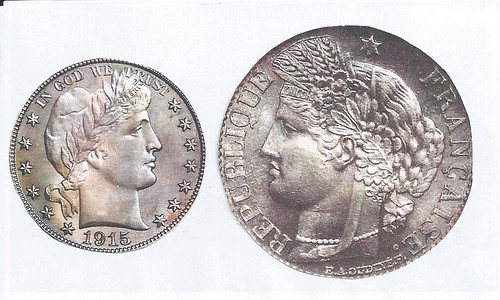
To read the earlier E-Sylum article, see: MORE COIN DESIGN SIMILARITIES: BARBER AND WEINMAN (www.coinbooks.org/esylum_v16n33a21.html)
Russian Babies On Coins
Fred Michaelson writes:
This coin has Tsar Nicholas I on the obverse, and on the reverse is his wife Alexandra Feordorovna (Princess Charlotte of Prussia) surrounded by her 7 children. The one at the bottom left looks like a baby. I thought I had seen a similar one with Nicholas II, the last Tsar, but I couldn't find it.
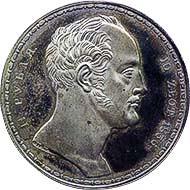
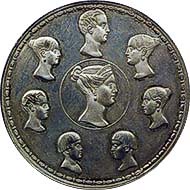
To read the earlier E-Sylum article, see: MORE BABIES ON COINS (www.coinbooks.org/esylum_v16n33a19.html)
On That eBay Lot of U.S. $100 Notes
Regarding the eBay listing mentioned last week, Jon Radel writes:
I read that as $1000 in 100s, I.e. 10 notes. Worth about 645 pounds so not a good deal at the lowered price of 800 pounds. They might even be real.....
To read the earlier E-Sylum article, see: EBAY STILL BANS CUBAN COINS AND BANKNOTES (www.coinbooks.org/esylum_v16n33a15.html)
Medal Commemorates Quicentenary of Florida's Discovery
Joseph Crespo writes:
A medal celebrating the 500th anniversary of the discovery of Florida has been commissioned by the Tampa Bay Coin Club through a private mint. Since the 1913 medal [HK-661], I do not think this event has been honored with any other piece. For a few more details visit the page http://tampabaycoinclub.org/Florida_s_Discovery_Me.html .

1933 DOUBLE EAGLE MOVES UPTOWN TO NEW-YORK HISTORICAL SOCIETY
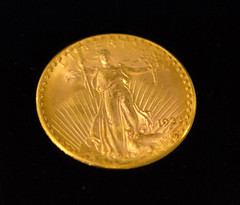 For 10 months, the world’s most valuable coin sat wrapped in plastic on a folding chair in a little cagelike compartment behind a bright blue door at the Federal Reserve Bank of New York. It was only a step or two away from billions of dollars’ worth of neatly stacked bars of gold bullion.
For 10 months, the world’s most valuable coin sat wrapped in plastic on a folding chair in a little cagelike compartment behind a bright blue door at the Federal Reserve Bank of New York. It was only a step or two away from billions of dollars’ worth of neatly stacked bars of gold bullion.
On Monday, a man in a dark suit stashed the coin in his briefcase and coolly walked out of the Fed’s heavily guarded limestone-and-sandstone building, a couple of blocks from the New York Stock Exchange in Lower Manhattan. He nodded politely to the guards on the front steps of the Fed. They did not stop him.
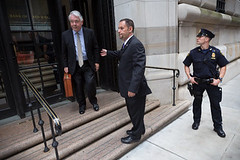 The man with the briefcase, David N. Redden, an auction-house executive, was not pulling off a heist. He was taking the coin on a 6.7-mile ride to the New-York Historical Society on Central Park West.
The man with the briefcase, David N. Redden, an auction-house executive, was not pulling off a heist. He was taking the coin on a 6.7-mile ride to the New-York Historical Society on Central Park West.
“It’s history,” Louise Mirrer, the president of the historical society, said of the coin after Mr. Redden had turned it over to curators who fitted it into a display case. “We have lots of priceless objects, but it’s always exciting to have the most valuable anything.”
The coin is valuable — Mr. Redden auctioned it at Sotheby’s for $7,590,020 in 2002, at the time the highest price any coin has ever sold for — because it should not exist. That is why it has inspired four books, a documentary for the Smithsonian Channel and an episode of the cable-television drama “The Closer.”
Known to coin collectors as a double eagle because it was worth twice as much as a $10 eagle gold piece, it was struck in 1933, the year in which President Franklin D. Roosevelt took the United States off the gold standard. He also ordered that year’s run of $20 pieces destroyed, except for two that were earmarked for the Smithsonian Institution.
The double eagle that Mr. Redden put in his briefcase somehow escaped that fate. It apparently made its way to Egypt and back, and was seized by the Secret Service in a sting operation at the Waldorf-Astoria hotel in 1996.
“For collectors,” he said as the S.U.V. barreled up the West Side Highway, “it’s almost a mystical experience to look at it.” He said this while looking at an almost identical double eagle, one from 1923 that did not have to be destroyed because it had been in circulation. He carries that coin with him everywhere, the way other people carry their cellphones. (He has one of those, too.)
One element of the back story, he said, is the current owner, who has never been identified. “It’s one of the wonderful mysteries of coin collecting, who bought that coin,” Mr. Roach said.
Mr. Redden described the owner as “a fabulous collector who was completely captivated by the story of the coin,” but not a coin collector.
“After he bought it, he said, ‘I don’t want to take it home, I don’t want to put it in a bank vault — what should I do with it?’” Mr. Redden recalled. “I said the Fed is planning a show. It was the star of that show for years.”
But last fall, the Fed sent the coin off to the vault. “The owner is interested in letting the public see it,” Mr. Redden said. The historical society beckoned, and the two security men followed Mr. Redden from the S.U.V. through the society’s back door. They watched as exhibition designers polished its case and tested the alarm, just in case.
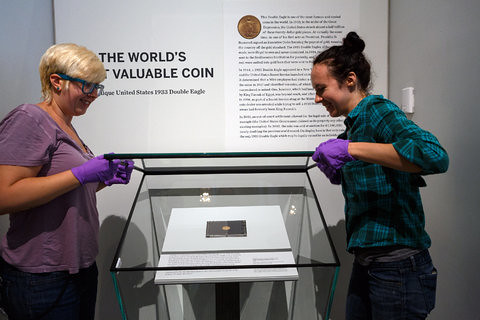
“I don’t know what the threat level on this particular item is, because if they steal it, who’s going to buy it?” one of the security men, Louis Guiliano, said. “If you can’t fence the coin, it’s not valuable. It’s only valuable if you can get someone to pay you.”
To read the complete article, see: A Coin Is Historic, Priceless and No Longer in a Vault (cityroom.blogs.nytimes.com/2013/08/12/a-coin-is-historic-priceless-and-no-longer-in-a-vault/)
To read some earlier E-Sylum articles, see:
DAVID LANGE ON SECURITY FOR THE ANA'S COIN RARITIES
(www.coinbooks.org/esylum_v16n32a07.html)
THE NEW-YORK HISTORICAL SOCIETY: RESPECT THE HYPHEN!
(www.coinbooks.org/esylum_v15n23a13.html)
THE BOOK BAZARRE
QUERY: INPUT FOR 'PRIVATE GOLD COINS' 2ND EDITION SOUGHT
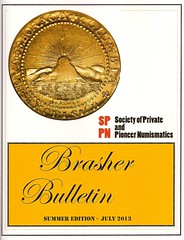 The Brasher Bulletin is a publication of the Society of Private and Pioneer Numismatics (SPPN).
The summer edition (July 2013) includes a review by Doug Nyholm of Paul Franklin's book, Anatomy of an Ingot. An article by Louis Carufel chronicles a visit to the Ironstone Heritage Museum two hours east of San Francisco, where displayed is the "Gold Pocket", "one of the world's most astonishing chunks of gold."
The Brasher Bulletin is a publication of the Society of Private and Pioneer Numismatics (SPPN).
The summer edition (July 2013) includes a review by Doug Nyholm of Paul Franklin's book, Anatomy of an Ingot. An article by Louis Carufel chronicles a visit to the Ironstone Heritage Museum two hours east of San Francisco, where displayed is the "Gold Pocket", "one of the world's most astonishing chunks of gold."
Other articles include one by Fred Holabird on California fractional gold pieces recovered from shipwrecks, and one by researcher Dan Owens on an 1849 gold rush venture - the Cayuga Joint Stock Company.
Reprinted in full is a great four-page article from the November 7, 1914 issue of The Engineering and Mining Journal on "Handling Gold Dust at Fairbanks", describing gold dust as a medium of exchange as well as a myriad of methods for swindling gold dust buyers.
Another Alaska item is a Serial #1 $10 National Currency brownback from Juneau, Alaska Territory.
Included with this issue is a seven-page note from author Don Kagin asking for reader input for a second edition of his book, Private Gold Coins and Patterns of the United States. Questions include how to handle the controversial Franklin/Ford issues, the Nagy fantasies, and whether and how to renumber listings to account for removed and added pieces.
Kagan had three general questions I thought I'd repeat for E-Sylum reader consideration. Can anyone help?
- Who was Ferdiand Gruner?
- Who was Walter L.S. Langerman?
- What do you know about collector/dealer Don Keefer?
QUERY: OVERSTRUCK CONFEDERATE HALF RESTRIKE SOUGHT
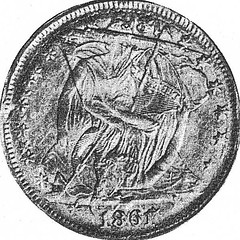

George Corell writes:
Attached are two pictures of a coin that appeared in "The Numismatist" in April of 1950. I was wondering if and E-Sylum knows the present whereabouts of this coin or who has it? Even who last is known to have had it so I can pick up on the trail and hopefully locate its present owner? While the pictures are useful, they are of poor enough quality to be less than definitive for my research needs. This coin may help answer a few questions if I can view it or view high resolution pictures of it.
QUERY: WHICH COUNTRIES HAVEN'T DEMONETIZED THEIR OLD MONEY?
A friend of mine asked:
Aside from the USA, have any other countries not de-monetized their modern coinage & currency? "
Mind you, I'm aware that Trade Dollars were declared non-legal tender at one point, but other than that, any coin or banknote issued by the United States is still redeemable at face value (even if that would be dumb based on a collector value above face).
So how would E-Sylum readers answer (or re-phrase) the question? Most countries have gone through revaluations where older money became worthless (typically, if not traded in by a certain deadline). But not the U.S. A worn, tattered, dirty, beat-up fractional note from the Civil War can still be deposited in a bank account at face value (once the teller is made aware of the law, hopefully by their manager). Can that be done with any other country's obsolete money?
QUERY: WERE WALTON'S COINS REALLY SCATTERED ON THE HIGHWAY?
We've had several articles recently relating to dealer George O. Walton. He met his end while travelling to a coin show in 1962 with his 1913 Liberty nickel. The incident is often reported thusly:
A North Carolina collector, George O. Walton, purchased one of the coins in the mid-1940s for a reported $3,750. The coin was with him when he was killed in a car crash on March 9, 1962, and it was found among hundreds of coins scattered at the crash site.
To read the earlier complete article, see: Rare 1913 nickel fetches over $3.1M at auction (www.redding.com/news/2013/may/05/rare-1913-nickel-fetches-over-31m-auction/)
Pete Mosiondz, Jr. writes:
Let me begin by saying that I always enjoy Harvey Stack’s reminiscences. I would like to comment about what I believe to be an old wives' tale concerning George Walton’s coins being “scattered all over the highway” after the crash. I had a couple of small transactions with Walton while he was alive. I was very young and was dealing on a small scale with a limited budget. George was a true gentleman who took care of my meager needs.
After his death I happened to communicate with one of the officers who was first on the scene at the time of the crash. He told me that there were no coins on the highway and that everything was intact. Of course the officer wouldn’t have known about a 1913 Liberty Head nickel so that point never came up. It would be interesting to hear from others who may have knowledge about the crash.
To read the earlier E-Sylum article, see: HARVEY STACK ON THE GEORGE O. WALTON COLLECTION. PART III (www.coinbooks.org/esylum_v16n33a17.html)
THE UNSOLVED MYSTERIES OF NUMISGRAPHICS
Three mysteries, however, still swirl around this great book.
First: Why were sales of the original 1876 edition of Numisgraphics so dismal?
Second: 10 special “large paper” copies were published. Where are they today?
Third: What happened to the photolithographs Attinelli made of the Watkins Broadside (the earliest coin auction that he could find)?
Only the first mystery has been solved; the other two still confound us.
Regarding that first question, the market of those interested in books about coin books was smaller than the market for those interested in books about coins. As John W. Adams observes in his Foreword to the 1976 Quarterman reprint of Attinelli’s work, Attinelli made matters worse by choosing to distribute Numisgraphics himself, thus foregoing a publisher’s marketing budget.
Numisgraphics received only one blandly positive review. All of these factors combined for dismal sales. Only about 50 copies were printed in 1876, and estimates of survivors range from Adams’ less than a dozen, to Charles Davis’ reckoning, in his American Numismatic Literature, of less than 25.
As Adams notes, the original edition was recognized as a rarity almost from the moment of publication; it began appearing on collectors’ want lists as early as 1879.
To read the complete article, see: Two mysteries left to solve (www.coinworld.com/Articles/ViewArticle/two-mysteries-left-to-solve)
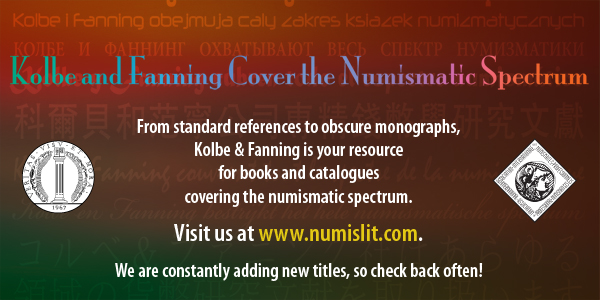
L.G. KAUFMAN'S DOLLARS OF THE WORLD EXHIBIT
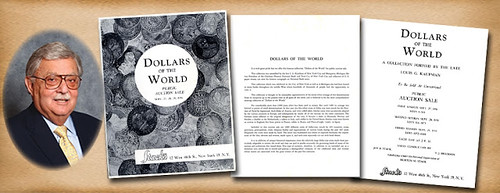
Many coin collections have themes, whether it is a special series or denomination run, or a period of time, or design differences between periods of issue. Such collections have always been interesting to me as some can be very similar but still are reflections of the collectors who created them. Collectors often follow patterns that others have taken before and then set themselves a goal that their collection could be more extensive, or be of better quality, or have a twist that the previous collection did not have. One very interesting collection from 1951 comes to mind.
In that year we were contacted by a bank in Michigan who asked us to sell a collection that they had on display. It was called “Dollars of the World” and contained some 1,600 different dollar size (crown size to our collecting friends) coins. Covering issues from 429 countries, the accumulation included from the earliest issue dated 1486 to when the collector stopped.
The collection was formed by L.G. Kaufman, a banker of great renown at the time, and was exhibited first in New York City and Marquette, Michigan. He was president of the Chatham Phoenix National Bank and Trust Company, and collectors of U.S. currency can note his signature on National Bank Notes. The “Dollars of the World” collection was exhibited all over the United States as an educational display, and hundreds of thousands of people had the opportunity to see it before it was consigned by the Marquette Bank for auction by Stack’s.
The exhibit showed examples of the earliest dated dollar-size coin, issued by Sigismund in Tyrol, and called the “taler.” This became a standard size and weight for coins to be used for payment for debts and services in countries worldwide. Many countries and states issued coins of this size for easy trade purposes and it was often called by similar, yet different names. For example, in Denmark, Norway and Sweden it became “daler.” In Germany it was “taler” or “thaler,” in Italy it was “tallero,” and in the United States it was “dollar.” In England it was known as a “crown,” in France “five francs,” in Russia a “ruble” and in Spain an “eight reales” or “piece of eight.” All of these and more were included in the “Dollars of the World” display.
The collection was shown on large trays, with wooden dividers, each opening measuring about two inches square, with some 24 openings on each tray. Each coin was numbered on a green card set below the coins, and six trays were inserted into a leather box, which was fitted into a special shipping trunk so it could be transported easily. Each coin was likewise described in a booklet that helped those who viewed the exhibit know just what they were seeing and admiring. The booklet descriptions covered the 429 countries, states, provinces, principalities, cities, religious bodies and organizations of various kinds that struck these coins over 442 years.
Mr. Kaufman often accompanied the exhibit to give lectures about the history surrounding the coins. After he passed away, one of his banks in Michigan in 1951 decided that the cost of maintaining the exhibits was too much for them to underwrite, though they knew it did provide an excellent tool for studying finance and history and that many had benefited from seeing it. It was then that Stack’s was selected to offer it for sale at public auction. The sale attracted collectors from all over the United States, many of whom had heard about or seen the exhibit and wanted to own some of the coins from this noteworthy collection.
To read the complete article, see: Remember When: The “Dollars Of The World” Collection (stacksbowers.com/Blogs/remember-when-dollars-of-world.html)
INTERVIEW WITH DE LA RUE EXECUTIVE DOUGLAS DENHAM
 Producing billions of banknotes every year, the Basingstoke-based firm has rolled off more than 150 national currencies in the past five years. But where does that money go? And what happens when a revolution breaks out? We asked De La Rue’s commercial legal director, Douglas Denham about the modern money-making business – and what on earth happens to the readies in a warzone.
Producing billions of banknotes every year, the Basingstoke-based firm has rolled off more than 150 national currencies in the past five years. But where does that money go? And what happens when a revolution breaks out? We asked De La Rue’s commercial legal director, Douglas Denham about the modern money-making business – and what on earth happens to the readies in a warzone.
At the height of the Libyan revolution in 2011 Denham found himself on a propeller plane flying into the Libyan city of Benghazi. De La Rue had been the incumbent printer of Libya’s currency but when Colonel Gaddafi was toppled in October the UN imposed sanctions and the money was seized.
“It was an intense six months for the legal team as we effectively had two competing governments – the National Transitional Council (NTC) and the Gaddafi regime – both claiming their appointees were the lawful representatives of the Central Bank of Libya, and they wanted their notes back,” explains Denham, who joined De La Rue as a legal adviser 18 years ago. “We had to decide who the lawful government was, who was in control of the central bank and who was recognised by other governments. We had to balance the challenges of public international law and the ‘recognition characteristics’ of the legal government with our contractual legal responsibilities and potentially new people coming into power.”
These are an unusual set of questions for a lawyer – questions that do not get answered from a comfortable office in Basingstoke.
After the sanctions were put in place Denham flew to Benghazi with Hogan Lovells partner Jeremy Brittenden, who was advising the NTC on a bid to have 1.86bn Libyan dinar (£948m) flown back to the country.
“When the pilot told us we were going to have to do a ‘corkscrew’ landing because of the risk of missile attack, it brought home to me the realities and dangers of war,” Denham recalls. “We were then warned that our biggest risk on the ground was between vehicle and destination – we could get shot at between the plane and our car, or between our car and our hotel – it was very out of the ordinary for a lawyer to be in that situation.”
Maybe so, but for De La Rue’s small legal team – consisting of Denham, who reports to general counsel Ed Peppiatt, two lawyers, one trainee and two support staff – there are very few ordinary situations on their travels.
Denham has visited more than 30 countries since joining the business and has travelled everywhere from Mongolia – “where it was -40 degrees in the night” – to Haiti, “where my hotel room walls were covered in bulletholes”.
He has advised on the production of banknotes after political change, including the new Libyan notes in February and the new Iraqi dinars printed in 2003.
To read the complete article, see: In-house interview: Danger money (www.thelawyer.com/in-house/in-house-interview/in-house-interview-danger-money/3008211.article)
FURTHER PRODUCTION PROBLEMS WITH THE NEW $100 BILLS
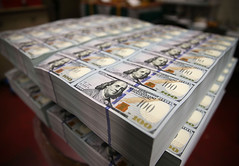 For the past few years, the Federal Reserve has been preparing to introduce a redesigned hundred-dollar bill into circulation. It will have a Liberty Bell that changes color, a new hidden message on Ben Franklin’s collar, and tiny 3-D images that move when you tilt the bill this way or that. But delay has followed delay. And now again: The New Yorker has learned that another production snafu has taken place at one of the country’s two currency factories, according to a document from the Bureau of Engraving and Printing.
For the past few years, the Federal Reserve has been preparing to introduce a redesigned hundred-dollar bill into circulation. It will have a Liberty Bell that changes color, a new hidden message on Ben Franklin’s collar, and tiny 3-D images that move when you tilt the bill this way or that. But delay has followed delay. And now again: The New Yorker has learned that another production snafu has taken place at one of the country’s two currency factories, according to a document from the Bureau of Engraving and Printing.
The cause of the latest blunder is something known as “mashing,” according to Darlene Anderson, a spokeswoman for the bureau. When too much ink is applied to the paper, the lines of the artwork aren’t as crisp as they should be, like when a kid tries to carefully color inside the lines—using watercolors and a fat paintbrush.
Anderson said this happens “infrequently.” Still, this foul-up is only the latest embarrassment for the bureau. The redesigned hundred-dollar bill was meant to be released in early 2011, but has been delayed for the past two years because of a massive printing error, separate from the recent mashing problem, in which some notes were left with a blank spot.
This time, recent batches of cash from the Washington, D.C., plant contained “clearly unacceptable” bills intermixed with passable ones, according to a July memo to employees from Larry Felix, the bureau’s director. So the Fed is returning more than thirty million hundred-dollar notes and demanding its money back, Felix wrote. Another thirty billion dollars’ worth of paper sits in limbo awaiting examination, and Fed officials have informed the bureau that they will not accept any hundred-dollar notes made at the Washington, D.C., facility until further notice.
Felix’s letter says internal quality-control measures should have prevented the bureau “from delivering defective work,” and that those responsible would be held accountable. The bureau now has to race to meet an October 8th deadline for delivering the year’s cash orders and to finally get the new hundred-dollar bill into circulation as promised. To that end, Felix has ordered the country’s other money factory, in Fort Worth, Texas, to accelerate its efforts. “There are dire consequences involved here because BEP sells Federal Reserve notes to the Board to finance our entire operation,” he wrote in the memo. “If the BEP does not meet the order, the BEP does not get paid.”
The financial toll from the recent bungle is tough to know: the Treasury and the Fed have little interest in calculating it, let alone being transparent about it. Still, the direct cost probably isn’t greater than the sum of what the bureau pumps out in a few days. “Central banks are a bit like other businesses,” said Ben Mazzotta, a researcher at the Fletcher School’s Institute for Business in the Global Context who focusses on the costs of different forms of money. “They can draw down inventories or order additional product.”
There are other costs, though. Taxpayers will have to pay to inspect, correct, produce, transport, and secure all the additional money that will replace the botched notes. Disposing of the bad bills? That’s on taxpayers, too, as are the additional hours spent making up for the mistake by employees of the bureau.
To read the complete article, see: A BLUNDER AT THE MONEY FACTORY (www.newyorker.com/online/blogs/newsdesk/2013/08/blunder-at-the-money-factory.html)
COMPANY MAKES A BITCOIN VENDING MACHINE
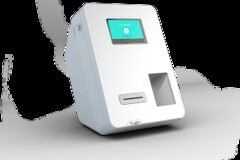 Bitcoin startup Lamassu Bitcoin Ventures, the makers of a Bitcoin ATM which promises to eat your paper (fiat) money and spit Bitcoins into your digital wallet in return, have funded their initial production run of 15 units a few hours after kicking off pre-orders (via their website) — taking the bulk of payments in Bitcoin, fittingly.
Bitcoin startup Lamassu Bitcoin Ventures, the makers of a Bitcoin ATM which promises to eat your paper (fiat) money and spit Bitcoins into your digital wallet in return, have funded their initial production run of 15 units a few hours after kicking off pre-orders (via their website) — taking the bulk of payments in Bitcoin, fittingly.
What’s the point of a Bitcoin ATM? The aim is to lower the barrier of entry to the digital cryptocurrency — which still very much ‘reeks of geeks’ (and investors) at this still early stage in its development – by letting people swap banknotes for Bitcoin in person. Of course there are myriad ways to do fiat-to-Bitcoin currency exchanges online but the Bitcoin ATM doesn’t require the user to sign up to an online exchange service in order to get some Bitcoin. (Albeit, users of the ATM do need to have their own Bitcoin wallet to store their exchanged BTCs).
The Bitcoin ATM accepts paper currency only but there’s no minimum limit (yes, you can exchange $1 to get around 0.009 Bitcoin, at current exchange rates, if you really want). It only accepts cash, so no debit/credit card payments — a deliberate choice by its creators to keep their costs and complexity capped by not having to deal with banks.
They argue it also makes things simpler for purchasers of the ATM itself, being as they don’t have to gain bank approval to get the machine up and running. However they do warn that buyers still need to make sure they comply with any pertinent financial regulations in their own country (Bitcoin regulations can’t even charitably be called ‘a work in progress’ yet, and the Bitcoin policy confusion varies from country to country).
To read the complete article, see: Bitcoin ATM Makers Open Pre-Orders & Fund Initial Run Of 15 Banknote-Eating Machines (techcrunch.com/2013/08/16/bitcoin-atm-funds-first-run/)
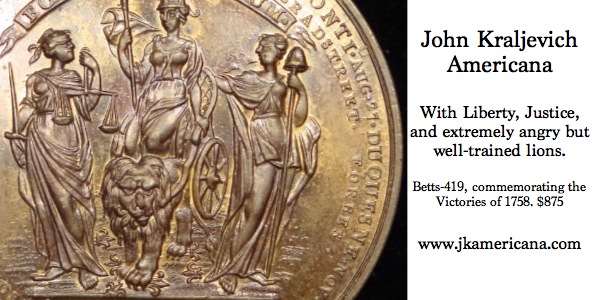
WESSEL ISLANDS SEARCH YIELDS SOME CLUES TO COIN ORIGINS
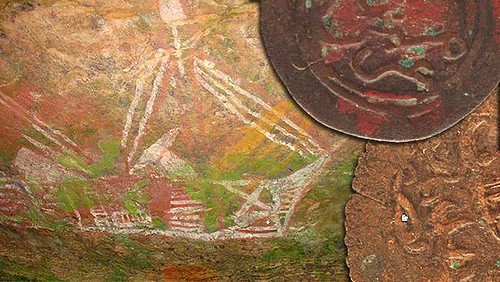
One of the rock art paintings discovered during last month's expedition to the Wessel Islands and, inset, two of the medieval African coins that sparked the search.
IT'S an adventure story involving medieval African coins, a confusing map and some of Australia's most rugged coast. But a recent expedition to a remote island off the Northern Territory has the potential to rewrite Australia's history.
An expedition sponsored by Australian Geographic last month travelled to the remote Wessel Islands to find the spot where five 1000-year-old African coins were discovered by a curious RAAF serviceman in 1944.
While they didn't find more coins, what they did find has already inspired a return expedition to the islands next year in the hope of rewriting the history of the first seafarers to reach Australia's shores.
Rock art pictures of sailing vessels and unusual men, along with intriguing samples of washed up shipping timbers and metalwork are being examined ahead of a return to the area next year to explore waters around the island for wrecks.
The researchers are actively exploring the possibility that the African coins came from a medieval Arab trading ship plying a route that linked Zimbabwe, Kilwa, Arabia, Persia, India and islands in the Indonesian archipelago such as Banda and Ambon. Cloves from these islands have been found in 3500-year-old burial pits in Syria and Egypt.
The wreck of just such a Persian dhow trading vessel was found off Sumatra in 1998. The coins could also have been from a Portuguese vessel as the seafaring nation conquered the African Kilwa kingdom in 1505 and regularly traded with islands north of Darwin. The first recorded visit of Europeans to the Wessel Islands was by the Dutch in 1623.
he team, part of a collaboration between Indiana University and the Australian National University, has sought to increase the chances of a major find by teaching the locals - including the Aboriginal owners of the land, the Warramiri-Golpa clan, indigenous Rangers and NorForce defence personnel - how to recognise historically significant artefacts and sites.
The mystery of the medieval coins began 60 years ago when Australian soldier Morry Isenberg was serving at a World War II radar station established on the island to track the Japanese raids on the Top End.
To read the complete article, see: Search for shipwrecks after medieval coins found in Wessel Islands leads to rock art, possible wreckage (www.news.com.au/national-news/search-for-shipwrecks-after-medieval-coins-found-in-wessel-islands-leads-to-rock-art-possible-wreckage/story-fncynjr2-1226695924312)
UNIQUE ANCIENT BRITISH COIN OF AMMINUS FOUND
On 2 June 2013 an important ancient British coin – a silver unit of a previously unrecorded type – was found at Staple in east Kent, former land of the Cantiaci. It was struck by Amminus (‘friend’), a Cantian king of Catuvellaunian origin who ruled in Kent around AD 30-40, shortly before the Claudian invasion in AD 43, which he may have encouraged.
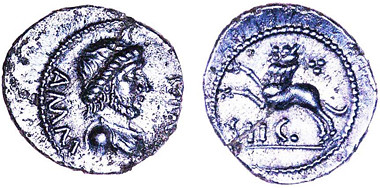
The coin has a Roman-style bust of Amminus and may be a portrait of him. He wears a loose-fitting tunic and his head is crowned by a rope-like jewelled fillet. This exotic headband is unlike any other I can recall seeing on a British, Gaulish or Roman coin of the period. On the other side of the coin is a bounding lion. Its mane is engraved in the same rope-like manner as the king’s flamboyant fillet – surely no coincidence.
Under the lion are the letters SIIC which may be read as SEC or SEG, which is probably an abbreviation of Sego (‘strong’ or ‘victorious’), which could be the first part of a mint-name such as Segodunon (‘strong fort’). Other coins of Amminus were minted at Duno (‘the fort’).
Little is known of Amminus and much of that, such as the right way to spell his name, comes from his coins. He is almost certainly the historical Adminius who fled as a refugee from Britain in AD 39 or 40 and who surrendered to the Roman emperor Caligula (‘little boots’) when the latter was stationed on the Rhine at Durocortorum (Mainz, Germany).
The newly discovered Amminus Lion silver coin will be sold by auction in November by Elizabeth Cottam of Chris Rudd. For their help with this brief report I thank Jane Bottomley, David Holman, Dr Ian Leins, Dr Daphne Nash Briggs and Dr John Sills.
To read the complete article, see: Unique coin of British king who fled to Germany (www.coinsweekly.com/en/Unique-coin-of-British-king-who-fled-to-Germany/8?&id=322&type=a)
COINS LEAD ARCHAEOLOGISTS TO ROMAN FIND
The major Roman fort complex was spotted on parched grassland near Brecon, Powys, and the marching camp near Caerwent in Monmouthshire.
Aerial archaeologist Toby Driver said he could not believe his eyes when he spotted the fort from the air.
He targeted reconnaissance flights in a light aircraft to where the drought conditions were most severe across the length and breadth of Wales.
When crop marks show in drought conditions Dr Driver said the Royal Commission's aerial survey only has a few weeks to record the sites before rain or harvest removes them.
The Roman fort complex discovery near Brecon was a "rare discovery for Wales" and was made following a tip from Dr Jeffrey Davies, who he has been working with on another project - the Abermagwr Roman villa excavations near Aberystwyth.
"Jeffrey Davies noticed an anomaly in Roman coin finds near Brecon, reported under the Portable Antiquities Scheme (PAS)," explained the aerial archaeologist.
"He had a hunch that the coins, of the Emperor Claudius, could indicate a lost early Roman fort, and passed a grid reference to me the day before a flight into central Wales.
"I couldn't believe my eyes when the pilot and I approached the location and saw fading crop marks of a major Roman fort complex, lost beneath fields and a road for nearly 2,000 years."
The Royal Commission will now begin cataloguing and mapping the discoveries to make the information more widely available online.
To read the complete article, see: Hot summer unearths Roman discoveries in Wale (www.bbc.co.uk/news/uk-wales-23628630)
IRONSIDE’S ‘LOST’ ROYAL ARMS DESIGN STRUCK
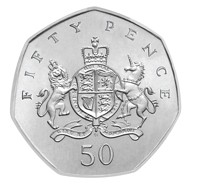 After nearly forty-five years, The Royal Mint has revived a coin design created by one of the 20th century’s most influential designers, Christopher Ironside. In celebration of the 100th anniversary of his birth, a special 50 pence coin bearing Ironside’s ‘lost’ Royal Arms design will enter circulation this year, and will also be minted in collectable precious metal editions.
After nearly forty-five years, The Royal Mint has revived a coin design created by one of the 20th century’s most influential designers, Christopher Ironside. In celebration of the 100th anniversary of his birth, a special 50 pence coin bearing Ironside’s ‘lost’ Royal Arms design will enter circulation this year, and will also be minted in collectable precious metal editions.
Ironside’s Royal Arms design lost a competition in 1969 when the Royal Mint Advisory Committee was tasked with choosing between two designs for the nation’s new decimal fifty pence piece.
The committee chose Ironside’s seated figure of Britannia. But, the highly-regarded Royal Arms design was liked so much by members of RMAC, trial pieces were made in the hope that one day a use would be found for them. That remained unseen until now.
This year the design is reborn in many forms. The Royal Mint has issued a 50p brilliant uncirulated piece, a 50p gold proof, a 50p silver piedfort proof and a 50p silver proof coin.
In a nod to Ironside, the 2013 version of the coin includes the designer’s initials, C.I.
Ironside’s wife Jean recalled an article written in 1969 in which her husband said, “The work of a great many artists who are geniuses is never recognised and probably eventually disappears. But if one is a coin designer, one’s work lasts possibly long after death, everyone becomes familiar with it and it forms a small part of the history of the country for which it was designed.”
To read the complete article, see: Royal Mint Revives 'Lost' Design (www.numismaster.com/ta/numis/Article.jsp?ad=article&ArticleId=27121)
DINER OFFERS 1964 PRICES (WHEN PAID IN SILVER COINS)
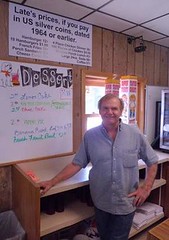 Late’s diner on S. Ninth Street is giving people a reason to break open their piggy banks and empty out their pockets for loose change.
Late’s diner on S. Ninth Street is giving people a reason to break open their piggy banks and empty out their pockets for loose change.
Late’s Burgers — known for their deep-fried cheese curds and burgers — is offering customers 1964 pricing if they come in and pay with coins minted before 1965.
Why?
Restaurant owner Karl Birkenstock said the answer to that is simple. The idea originally crossed Birkenstock’s mind because of the increased conversation about how goods have become more expensive.
“I decided to illustrate that by taking all of our prices and applying what the cost of it would be if you were paying in the currency of the ‘olden days,’ being 1964 or before, with silver coins,” Birkenstock said.
What started out as an idea to show people that the price of food is rising with inflation like other goods, like gas, ended up being a good marketing strategy that’s gotten national attention, he said.
“It has worked as a marketing tool,” he said. “We’ve received national attention ... we’ve received other news photos. So it’s been effective like that and I didn’t expect that as being one of the benefits.”
When the deal started, people talked about it so much that it drove the point home.
“I really didn’t expect that we were going to have a whole lot of people do it, but now, people are actually using it and I welcome it,” Birkenstock said.
When Birkenstock converted a menu to show 1964 pricing, there were some pretty radical changes. For instance, hamburgers were 12 cents and 100 pieces of chicken could be bought for $4.55.
“I think that went a long way to demonstrate to customers that it isn’t our prices, but it is actually the currency has depreciated.”
To read the complete article, see: Late's diner offers 1964 prices to customers paying with silver coins (www.htrnews.com/article/20130814/MAN0101/308150187/Late-s-diner-offers-1964-prices-customers-paying-silver-coins)
THE BOOK BAZARRE
CROW TRIBE PLANS TO ISSUE ITS OWN CURRENCY
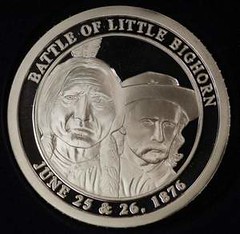 The director of the Crow Tribe’s business development department hopes creating a tribal currency will spur tribal members to spend money on the reservation and encourage the creation of more businesses.
The director of the Crow Tribe’s business development department hopes creating a tribal currency will spur tribal members to spend money on the reservation and encourage the creation of more businesses.
The tribe is minting copper, silver and gold coins called “scouts” to serve as its sovereign currency, The Billings Gazette reported Friday.
Ceivert LaForge, director of the tribe’s LLC Department, has been working on the project since March with Eddie Allen, director of the Dallas-based Sovereign Economics. The company’s website says it helps “nations, states, communities and groups” establish their own currencies.
The tribe plans to introduce the new currency Friday evening during the Crow Fair powwow.
To help finance the launching of the Crow currency, the tribe commissioned 1,000 one-ounce silver medallions commemorating the Battle of the Little Bighorn. They are not currency and are being sold for $50 each, mainly to coin collectors.
The tribe hopes to introduce the currency gradually, possibly by having tribal employees receive some of their pay in scouts, with the proportion of Crow currency increasing over time.
The Crow scouts will include six coins — two copper, two silver and two gold — each stamped with the image of a different Crow chief.
To read the complete article, see: Crow Tribe hopes to have its own currency (www.greatfallstribune.com/viewart/20130816/NEWS01/308160019/Crow-Tribe-hopes-its-own-currency)
INDIA'S CLEAN BANKNOTE POLICY
 The Reserve Bank today asked banks to issue suitable instructions to all officers and staff not to scribble or write on banknotes.
The Reserve Bank today asked banks to issue suitable instructions to all officers and staff not to scribble or write on banknotes.
RBI said it was observed that in certain bank branches the practice of writing or scribbling on the body of the banknotes continues to remain in vogue. Accordingly, such banknotes get treated as soiled banknotes and cannot be recirculated.
"You (banks) are advised to issue suitable instructions to all dealing officers and staff to forthwith stop writing/ scribbling of any kind on any part of the banknote to ensure achievement of the objectives of Clean Note Policy," it said in a notification.
Under the present system of mechanised processing of banknotes, inscription or scribbling on any part of the banknote would render it to be classified as unfit for reissue.
To read the complete article, see: RBI asks banks not to scribble or write on banknotes (economictimes.indiatimes.com/news/news-by-industry/banking/finance/banking/rbi-asks-banks-not-to-scribble-or-write-on-banknotes/articleshow/21828043.cms)
An unknown Kashmiri separatist group called Kashmir Graffiti has become active in Jammu & Kashmir, stamping separatist slogans on Indian currency notes to voice their demands.
According to their statement posted on social networking site Facebook, the group has stamped currency worth Rs 30 crores in the last four months. The group has also put a video on YouTube about it.
According to the Reserve Bank of India's clean note policy announced on May 10 this year, inscription or scribbling on any part of the banknote would render it to be classified as unfit for reissue. Accordingly, such banknotes get treated as soiled banknotes and cannot be re-circulated.
Head of corporate communications, J&K Bank, Sajad Bazaz said the claim of Rs 30 crore branded with slogans is yet to be verified by the police. Action will follow, he said. "So far the currency is concerned the stamped notes can't be termed as invalid," Bazaz said.
To read the complete article, see: Separatist slogans on banknotes in J&K (timesofindia.indiatimes.com/india/Separatist-slogans-on-banknotes-in-JK/articleshow/21906103.cms)
GRAPHIC DESIGNER CRITIQUES THE JANE AUSTEN BANKNOTE
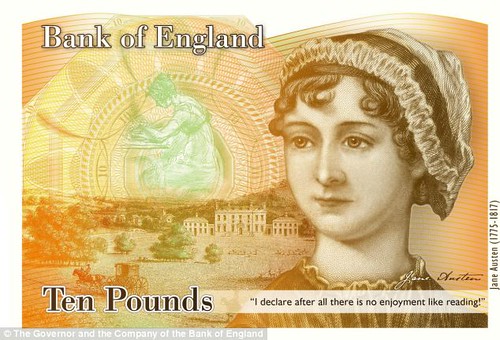
We tend not to think much about what our money looks like, but lots of us probably see the dead-president faces on our bills more often than, say, the faces of our mothers. The media frenzy surrounding England’s forthcoming Jane Austen 10-pound note has mainly focused on the successful grassroots campaign that persuaded the bank to replace Charles Darwin’s portrait with that of a female writer--and the disturbing hate-tweets that followed.
But what of the actual design of the banknote?
Co.Design spoke with Pentagram partner Paula Scher--the graphic designer behind plenty of iconic book jackets and the identities of everything from world-finance giants like Citibank to cultural leaders like The Public Theater--about the design of the controversial tenner.
“I am delighted that the British Government is putting Jane Austen on their paper money," said Scher. "No one wrote better about women and money."
The design of British paper currency in general, however, offers no such clear consensus. Its many, many visual and security elements, all packed into a few inches, include metallic thread, raised print, watermarks, an ultraviolet feature, microlettering, and holograms.
In other words, the brief is a graphic designer’s nightmare. But Scher thinks it may have ultimately benefited the bill’s designer, who had to embrace the mess: “I am suspicious about money that looks too well designed. It always looks a bit counterfeit to me,” she says. “I also don’t trust well designed wine labels for more or less the same reason. It’s often the lousiest wine. So I would frame my judgement in this way: Is the paper money believable? I think the answer is yes.”
To read the complete article, see: Designer Paula Scher Weighs In On The Jane Austen Banknote (www.fastcodesign.com/1673140/designer-paula-scher-weighs-in-on-the-jane-austen-banknote)
THE E-SYLUM ROYAL SEX CHANGE POETRY CORNER
Responding to an article about the lack of women on Bank of England notes, Joe Boling wrote:
I quote: "The move comes after the Bank faced criticism that a plan for Winston Churchill to feature on the new fiver meant there would not be a woman on any English note." When did Queen Elizabeth become male?
In an attempt at humor in the August 4, 2013 issue, I wrote:
She had the operation in 1985. You all know the medical name of the procedure to turn a woman into a man, right? An "addadictomy"... -Editor
To which Ron Guth wrote:
I fear the E-Sylum might have been hacked by the likes of Anthony Weiner or Bob Filner (our mayor here in San Diego). using the name "Editor." That's the only explanation I can think of for the "addadictomy" reference in the latest issue.
In response, Fred Michaelson penned a limerick:
Ron Guth said Wayne was rude
To include a word so lewd.
(Now I did hear a rumor
that Ron's without humor.)
My conclusion is he's a prude.
PS---Addadictomy was a GEM.
I forwarded the verse to Ron for comment, and he replied thusly:
Dear author of the limerick,
Your rhyme cut me to the quick,
But in my defense,
Wayne's word caused offense,
My sensitivities it did prick.
Just to be clear Ron certainly has a sense of humor in this; here's another of his verses:
Wayne wasn't rude,
He was just a little crude,
And I ain't no prude,
I've never worn a snood,
I liked "Hey Jude",
And I love Thai food,
What else do you nood (I mean need).
Finally, Her Majesty Queen Elizabeth II writes:
So not to stiffen me
Wayne had an epiphany
To undo the curse
He operated reverse
And gave me a lopitophomy
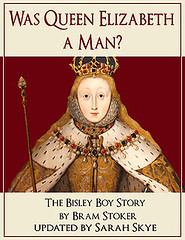 Was Queen Elizabeth I a man? My current projects are related to that intriguing legend.
Was Queen Elizabeth I a man? My current projects are related to that intriguing legend.
Ever since I read the article about Queen Elizabeth I rumors, I’ve been researching the history of that particular rumor and the evidence to support it.
My first discovery was Bram Stoker’s final nonfiction work, a book called Famous Impostors.
To read the complete article, see: Was Queen Elizabeth I a Man? Two New Books. (sarahskye.com/was-queen-elizabeth-i-a-man-two-new-books)
To read the original Daily Mail article, see: Is this proof the Virgin Queen was an imposter in drag? Shocking new theory about Elizabeth I unearthed in historic manuscripts (www.dailymail.co.uk/news/article-2337774/Is-proof-Virgin-Queen-imposter-drag-Shocking-new-theory-Elizabeth-I-unearthed-historic-manuscripts.html)
To read the earlier E-Sylum articles, see:
JANE AUSTEN BANKNOTE PROMOTER THREATENED
(www.coinbooks.org/esylum_v16n32a15.html)
NOTES FROM E-SYLUM READERS: AUGUST 11, 2013: Humor Rubs Ron Wrong
(www.coinbooks.org/esylum_v16n33a13.html)
REAL BOOKS PRICED LOWER THAN E-BOOKS
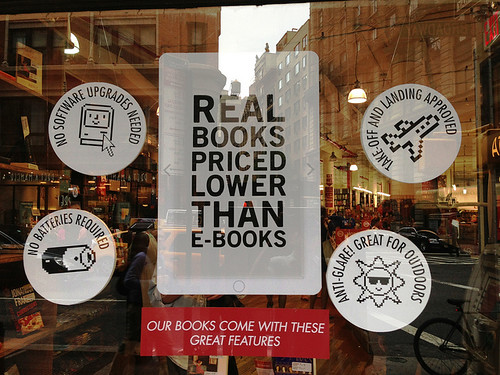
Avi Solomon snapped this pic of the window display at NYC bookstore The Strand lauding the virtues of their "Real books priced lower than ebooks," including the fact that you can read them during take-off and landing.
To read the complete article, see: How the Strand sells print books to ebook readers (boingboing.net/2013/08/16/how-the-strand-sells-print-boo.html)
FEATURED WEB PAGE: CAMP MONEY
This week's Featured Web Page is the Camp Money site (WorldAndMilitaryNotes.com). The link is from the August 2013 MPC Gram published by Fred Schwan.The purpose of this web site is to present information about what is sometimes referred to as camp money. Camp money would include Concentration Camps, Ghettos, Internment Camps, Prisoner of War Camps, and Displaced Persons Camps. Research in this area began shortly after World War II by Kisch and shortly after that by Keller. There have been many others that have written books and articles on the subject. This web site will hopefully review and add to the information printed but in an electronic format. I consider myself a student of the subject always trying to learn and discover more about it. I welcome any information about the subject or comments about any of the information presented in the web site.
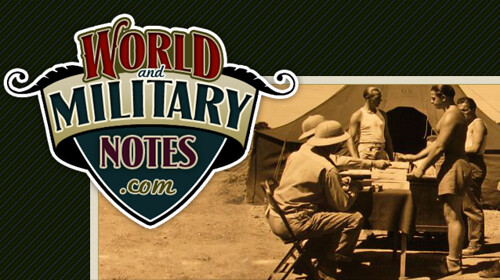
worldandmilitarynotes.com
